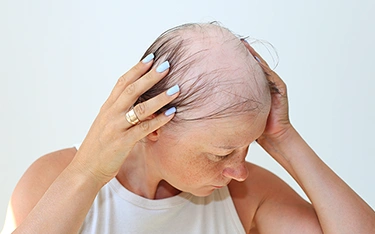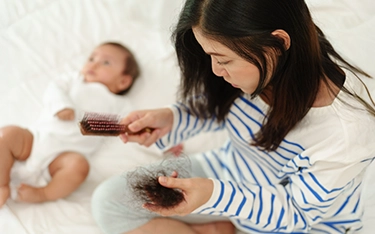This condition usually doesn’t happen overnight. However, in general, it is a rapidly progressing condition. Alopecia totalis starts like alopecia areata. In this condition, people often notice small bald spots on the scalp, which eventually spread and increase in size.
In some cases, especially when left untreated or triggered by stress or illness, these patches can merge, resulting in complete hair loss on the scalp. Alopecia totalis has a strong autoimmune connection. Our immune system is built to safeguard our body and fight against foreign and harmful invaders.
However, in autoimmune diseases, this system fails, and the body mistakes a healthy cell as an invader, in this case, hair follicles, and attacks them. This leads to inflammation that disrupts the hair growth cycle, ultimately causing hair to stop growing.
Why Does Alopecia Totalis Happen? Alopecia totalis is multifactorial, meaning it typically results from the combined effects of multiple factors. These factors can be both internal and external.
Here are some of the most common triggers and underlying causes
- Genetics: If you have a family history or a parent, sibling, or grandparent with autoimmune diseases, then it’s more likely to be passed down in the family tree.
Any autoimmune diseases like type 1 diabetes, thyroid disease, vitiligo, or rheumatoid arthritis can increase your chances of getting alopecia totalis. Fortunately, homeopathy can be an effective treatment for genetic hair loss
Read more:
- Immune system dysfunction: You can also be the first in the family to get alopecia totalis if your immune system misfires. Your body will start attacking healthy hair follicles in this type of autoimmune disease.
- Viral infections or illnesses: Sometimes, even something minor, such as the flu or the cold, can be the cause of Alopecia Totalis. It is not common for everybody. Instead, it occurs only in people whose immune systems remain overly active even after the flu is eliminated from the body.
- Hormonal changes: Women can suffer from alopecia totalis due to shifts in hormone levels during puberty, pregnancy, post-partum, or menopause. This can also happen when they start or stop birth control pills, which can upset the immune balance.
- Stress: This can be emotional or physical. Stress, however, doesn’t cause alopecia by itself, but it is a known trigger. This is especially true if your stress is chronic, as stress raises cortisol levels. High cortisol levels can confuse the immune system, leading to excessive hair loss.
In some cases, external factors can also be the cause of alopecia totalis. These may be minor on their own, but when combined with genetic or immune system factors, they tip the body into alopecia. Here are some of the common ones:
- Air pollution and chemicals: Frequent exposure to industrial pollutants, synthetic hair products, or harsh hair treatments, such as chemical straightening, may be the reason.
- Allergens: Dust mites, pet dander, or even reactions to skincare products can overstimulate the immune system.
- Smoking: Tobacco is a well-known compound that triggers autoimmune reactions. Learn why you should quit smoking if you have an autoimmune disease like diabetes.
- Certain medications: Some drugs like antidepressants, blood thinners, high blood pressure medicines, arthritis drugs, Parkinson’s treatment or chemotherapy can cause alopecia totalis.
It is important to note that alopecia totalis is not contagious and doesn’t indicate poor hygiene or nutrition on its own. It’s a complex internal process.
Read more -
Symptoms and Early Signs
Spotting the early signs of alopecia can help you slow down or even stop its progression. Alopecia totalis often begins as alopecia areata, which itself gets mistaken for general hair thinning or dandruff-related hair loss. Here’s what to look for:
- Patchy hair loss: This is the first sign of alopecia (i.e. Alopecia Areate), characterised by hair falling out in coin-sized patches. This can be without any pain or redness. These patches can appear on the scalp, beard or eyebrows.
- Progressive hair loss: If left untreated or triggered further, these patches of hair loss continue to grow larger and eventually merge. This leads to complete head baldness. This progression can happen gradually over several weeks or suddenly within a few days.
- Loss of eyebrows and eyelashes: In more advanced and aggressive cases of alopecia totalis, facial hair-like eyebrows and eyelashes may also thin or fall out completely. This can affect eye protection as there is nothing to ward off dust and light.
- Nail changes: Although this sign is not common to all patients of alopecia totalis, a study shows that about 40% of patients also see some nail changes. There can be pitting, ridges or brittleness of their fingernails. These signs sometimes occur even before the hair loss, so take them seriously.
- Scalp sensitivity or itching: Some people experience a tingling, itching, or mild burning sensation in the scalp before the hair falls out. This is usually an indication of faulty immune activity around the follicles.
These early signs may not always point to alopecia totalis, but they shouldn’t be ignored. Consulting a dermatologist at the first signs of patchy hair loss gives you the best chance at slowing or reversing progression at the right time.
Will Alopecia Areata Come Back or Progress?
Suffering from alopecia areata can be depressing, and the thought of the condition reappearing scares everyone who has been through it once. Unfortunately, the answer isn’t black and white.
Read more: How to mentally overcome Alopecia Areata
Both Alopecia totalis and Alopecia Areata are often a relapsing and remitting condition, meaning it can come and go unpredictably. Hair might regrow in some places, but then a new patch of hair loss can appear in some other area on the scalp.
In many cases, alopecia areata remains patchy but manageable. However, in severe cases, alopecia areata can progress to alopecia totalis (no hair on the scalp), which can further progress to alopecia universalis (no hair on the entire body).
That being said, early treatment can help in some cases to reduce the chances of progression and support regrowth.





